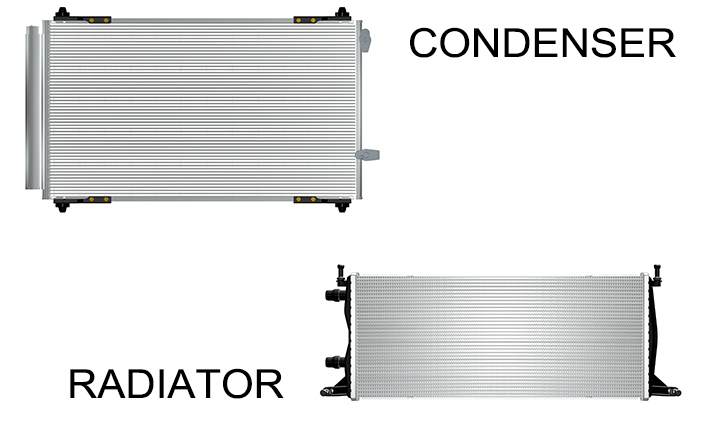The difference between automotive radiators and automotive condensers: Professional analysis and Consumer guide.
2025-03-27
In the automotive cooling system, the radiator and the condenser are two vital components, although they are similar in appearance and similar in location, but the function is very different. For the average car owner, understanding the difference between the two not only helps to properly maintain the car, but also to make more informed decisions when faced with repair options. This article will delve into the differences and provide practical advice from a consumer perspective.

Differences in core functions
The radiator is the core component of the engine cooling system, and its main function is to distribute the excess heat generated by the engine to the air through the circulating coolant (antifreeze) to prevent the engine from overheating. When the coolant flows through the hot engine, the temperature rises, and then it is pumped to the radiator, cooled by the heat sink and air contact, and then recycled back to the engine.
The condenser is an important part of the automobile air conditioning system, and its role is to condense the high temperature and high pressure gaseous refrigerant discharged by the air conditioning compressor into a medium temperature and high pressure liquid. This process is accomplished by heat exchange with the ambient air in preparation for the expansion of the refrigerant in the evaporator to absorb heat (refrigeration).
Simple memory method - radiator tube "engine temperature", condenser tube "air conditioning cool". When the air conditioner is not cool in summer, the problem may be in the condenser; The abnormal rise of the water temperature table may be a problem with the radiator.
Structure and location differences
Although both use similar tube-fin heat exchange structures, there are significant differences in details:
1. Material and pressure resistance:
Radiators are usually made of aluminum alloy and are designed for working pressures of about 1-1.5bar
The condenser is made of thicker aluminum alloy material due to the higher operating pressure of the air conditioning system (about 10-30bar)
2. Internal structure:
The inside of the radiator is a single channel, and the coolant flows as a whole
The inside of the condenser is usually divided into a condensing zone and a subcooling zone, and the structure is more complex
3. Installation position:
In most modern vehicles, the condenser is mounted in front of the radiator (near the front intake grille)
The radiator is located behind the condenser
This arrangement allows air to pass through the condenser and then the radiator
Due to the front position, the condenser is more vulnerable to external damage such as flying rocks and insect corpses. Checking the surface cleanliness of the condenser after a long drive is a good practice to ensure the efficiency of the air conditioner and reduce the burden on the radiator.
Differences in working medium and system
The radiator belongs to the engine cooling system, the working medium is water-based coolant (usually ethylene glycol mixture), the system includes:Water pump, Thermostat,Cooling fan,Expansion tank.
Condenser belongs to the air conditioning refrigeration system, the working medium is a special refrigerant (such as R134a or new R1234yf), the system includes:Compressor,Reservoir dryer,Expansion valve,Evaporator
There is a significant difference in maintenance cost between the two systems. Radiator problems can lead to engine overhauls (tens of thousands of dollars in losses), while condenser failures usually only affect air conditioning use. However, it should be noted that refrigerant leakage not only affects the refrigeration effect, but also the high cost of supplementing some new refrigerants (R1234yf).
Common faults and maintenance differences
Typical radiator problems:
1. Internal blockage (scale, rust)
2. External blockage (accumulation of insects and catkins)
3. Weld or plastic end cap leaks
4. The heat sink is damaged
Typical condenser problems:
1. Micro-leakage (joints, welds)
2. External blockage (dust and oil)
3. Corrosion perforation
4. The high pressure side is abnormal
Comparison of maintenance suggestions
Suggestions for radiator maintenance:
Preventive maintenance measures: Replace the coolant every two to five years, and keep the outside of the radiator clean to prevent dust, insects, or catkins from affecting the heat dissipation efficiency.
Replacement reference period: It is usually necessary to consider replacement after traveling 8-150,000 kilometers.
Typical maintenance costs: Depending on the model and brand, the cost of replacing the radiator is about 500-3000 yuan.
Condenser maintenance recommendations:
Preventive maintenance measures: It is recommended to conduct a comprehensive inspection of the air conditioning system every year before the summer, and avoid direct flushing with high pressure water gun during daily cleaning to prevent damage to the heat sink.
Replacement reference period: Generally, it is necessary to consider replacement when traveling more than 100,000 kilometers.
Typical maintenance costs: The replacement cost of the condenser is relatively high, ranging from 800 to 4000 yuan, depending on the model and the type of refrigerant used.
Whether it is a radiator or a condenser, the choice of original parts or reliable brand subsidiary parts can better guarantee the service life and performance. At the same time, regular inspection and proper cleaning can significantly extend the service life of these two components and avoid greater maintenance expenses.
When the radiator leaks, colored (often red, green, blue) liquid traces can be seen on the ground; The condenser problem is mostly manifested in the gradual decline of the refrigeration effect of air conditioning. Both may cause the engine to overheat due to poor heat dissipation, but the mechanism is different.
Summary
Understanding the difference between the radiator and the condenser helps the owner to judge the vehicle problem more accurately and communicate with the maintenance technician more professionally. Through scientific maintenance, these two key heat exchange components can work steadily for a long time, ensuring healthy engine operation while providing a comfortable in-car environment, ultimately improving the vehicle experience and reducing the total cost of ownership.